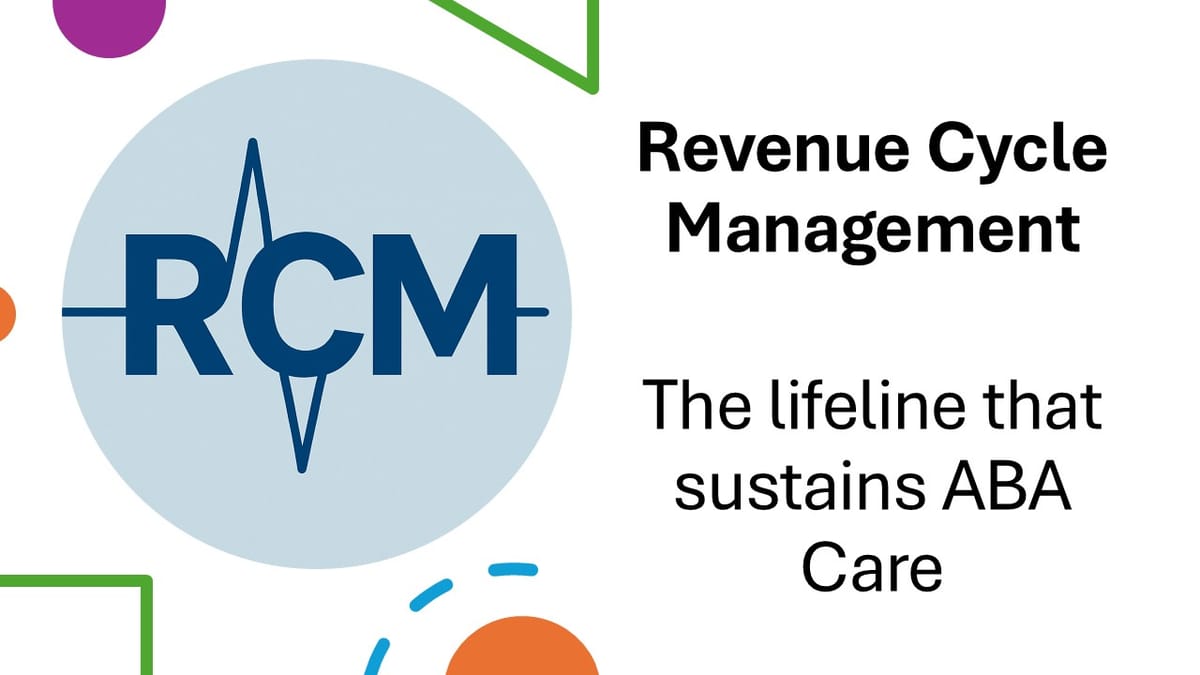RCM in ABA: Vendors, Platforms, and the Hybrid Model

Why RCM Matters in ABA
In ABA, revenue cycle management (RCM) is more than just billing — it’s the lifeline that keeps care accessible. Delays or errors in claims can create cash flow gaps, stall treatment, and frustrate both families and staff.
The decision to keep RCM in-house, outsource to a vendor, invest in a tech platform, or mix the two can shape not only financial performance but also brand perception.
When to Outsource to an RCM Vendor
Trigger points for outsourcing:
- Rapid growth outpacing internal billing capacity
- Persistent denials or rising days in A/R
- Expanding into new states or payor networks with unfamiliar rules
- Difficulty recruiting and retaining qualified billing staff
Strategic vs. tactical outsourcing:
- Full-service model: Vendor manages all billing functions end-to-end.
- Targeted outsourcing: Vendor handles specific workflows such as prior authorizations, eligibility checks, or denial management.
Platform Agnostic
Most RCM vendors can work inside any major ABA EHR or practice management platform — CentralReach, AlohaABA, Lumary, Motivity, Passage, and others.
Upside: Flexibility when switching systems or integrating acquisitions.
Downside: Vendors may not optimize the tech stack to its full potential without deep, platform-specific expertise.
Vendors as the Face of the Provider
In many arrangements, RCM vendors interact directly with payors and sometimes with clients or caregivers.
Opportunities:
- Professionalism and responsiveness can strengthen your brand.
Risks:
- Misaligned communication style or tone can erode trust.
- Limited visibility into these interactions if reporting isn’t robust.
- Inconsistent branding in calls, emails, or letters.
Ethical & Brand Considerations
Mission-driven ABA providers should evaluate:
- Caregiver Communication: Does the vendor use language and tone consistent with your values?
- Transparency: Are patient responsibility amounts explained clearly and respectfully?
- Values Alignment: Does the vendor’s approach reflect autism advocacy and care principles?
Integration with CRM
RCM vendors often operate in billing software without tying their work back into a provider’s CRM. This can create blind spots for intake, scheduling, and operations teams.
Benefits of better integration:
- Real-time visibility into claim and authorization status
- Faster coordination between intake, scheduling, and billing
- Linking financial KPIs to operational and clinical dashboards
How RCM Vendors Operate
- People: Mix of onshore and offshore labor to manage cost and coverage.
- Tech: Proprietary tools or third-party claim scrubbers, denial trackers, and automation systems.
- Processes:
- Pre-authorization & eligibility
- Claim submission & monitoring
- Denial management & resubmission
- Patient responsibility follow-up
Handling PHI
Any RCM partner must be HIPAA-compliant, with safeguards such as:
- SOC 2 or HITRUST certification
- Secure transfer methods (SFTP, encrypted APIs)
- Role-based access control
- Offshore staff under the same compliance obligations as onshore teams
KPI-Driven RCM Strategy
The best RCM setups — in-house or outsourced — run on measurable performance. Core KPIs include:
Days in A/R – Average time to collect after service
First-Pass Acceptance Rate – % of claims accepted on first submission
Denial Rate by Payor – Where revenue leakage is happening
Authorization Turnaround Time – Speed from request to approval
Net Collection Rate – How much of billed charges you actually collect
In-House RCM Challenges
Why many providers struggle to scale internal billing teams:
- Staff turnover and constant retraining needs
- Lack of payor-specific expertise for multi-state operations
- Limited automation or denial prevention tools
- Fragmented workflows between intake, billing, and clinical teams
RCM Vendors vs. RCM Tech Platforms
| Aspect | RCM Vendors (Services) | RCM Tech Platforms (Software) |
|---|---|---|
| Core Value | People + processes to execute billing end-to-end | Tools to help your team do the work more efficiently |
| Who Does Work | External vendor staff | Your internal team |
| EHR Relationship | EHR-agnostic, may lack deep optimization | Often deeply integrated, sometimes native |
| Scalability | Scale by adding vendor labor | Scale by expanding team use of features |
| Cost Model | % of collections or per-claim fee | Subscription or per-user fee |
| Brand Interaction | Vendor may interact with payors/clients directly | All interactions handled in-house |
| Risk | Dependency on external partner, knowledge loss | Underutilization if team lacks expertise |
Major RCM Vendors in ABA (Service Providers)
- ASP-RCM – Operations-first, ABA-specialized, strong denial management
- Plutus Health – Large-scale, multi-specialty RCM with dedicated ABA vertical
- BillMax – Offering from CentralReach. Deep ABA experience, strong ties to Change Healthcare infrastructure
- Missing Piece – Established healthcare RCM vendor focused on ABA
- SimiTree – Specialized billing services for ABA providers
RCM Tech Platforms (Software Tools)
- Camber – Tech-enabled RCM platform with automation and claim optimization; also offers optional managed services
- Silna Health – Prior-authorization and payor-readiness automation (often the most painful ABA workflow)
- Clearinghouse/Claim Scrubbers – Office Ally, Availity, Waystar, Change Healthcare
The Hybrid Model: Platforms + Targeted Vendor Support
- Tech provides the infrastructure.
- Vendors handle only the most labor-intensive or specialized pieces.
Common hybrid use cases:
- Pre-authorization & eligibility
- Denial management
- Overflow support during staffing shortages
- Managing low-volume, complex payors
Benefits:
- Lower overall cost than full outsourcing
- Retain brand control for most interactions
- Access to niche expertise without long-term staffing
Challenges:
- Integrating vendor updates into CRM and Practice Management platforms
- Avoiding data silos between teams
- Ensuring process consistency
The Role of Clearinghouses in ABA RCM
Even if you outsource to an RCM vendor or use a tech platform, there’s almost always a clearinghouse in the background.
Why Clearinghouses Matter
- First Pass Acceptance: Catch formatting and eligibility errors before claims hit payors
- Speed of Payment: Faster electronic transmission = faster reimbursement
- Error Transparency: Detailed rejection reports for quicker fixes
Common Clearinghouses in ABA
- Office Ally – Low-cost, widely used
- Availity – Strong payor network connectivity
- Waystar – Integrated analytics and denial tools
- Change Healthcare – Deep payor integration; used by BillMax
Emerging RCM Tech Signals (Watchlist)
- AI Denial Prediction – CentralReach's ClaimCheckAI and similar tools flag high-risk claims
- Integrated RCM + CRM – Salesforce-based Lumary, MeasurePM and similar platforms
- Payor API Connectivity – Real-time eligibility and claim status via networks like Availity
Other Factors to Evaluate
- Cost models and contract terms
- Data ownership and portability
- Reporting depth and KPI transparency
- Cultural fit and communication standards
- Breach response and PHI handling
Click here to subscribe for more insights on ABA technology, operations, and strategy.



